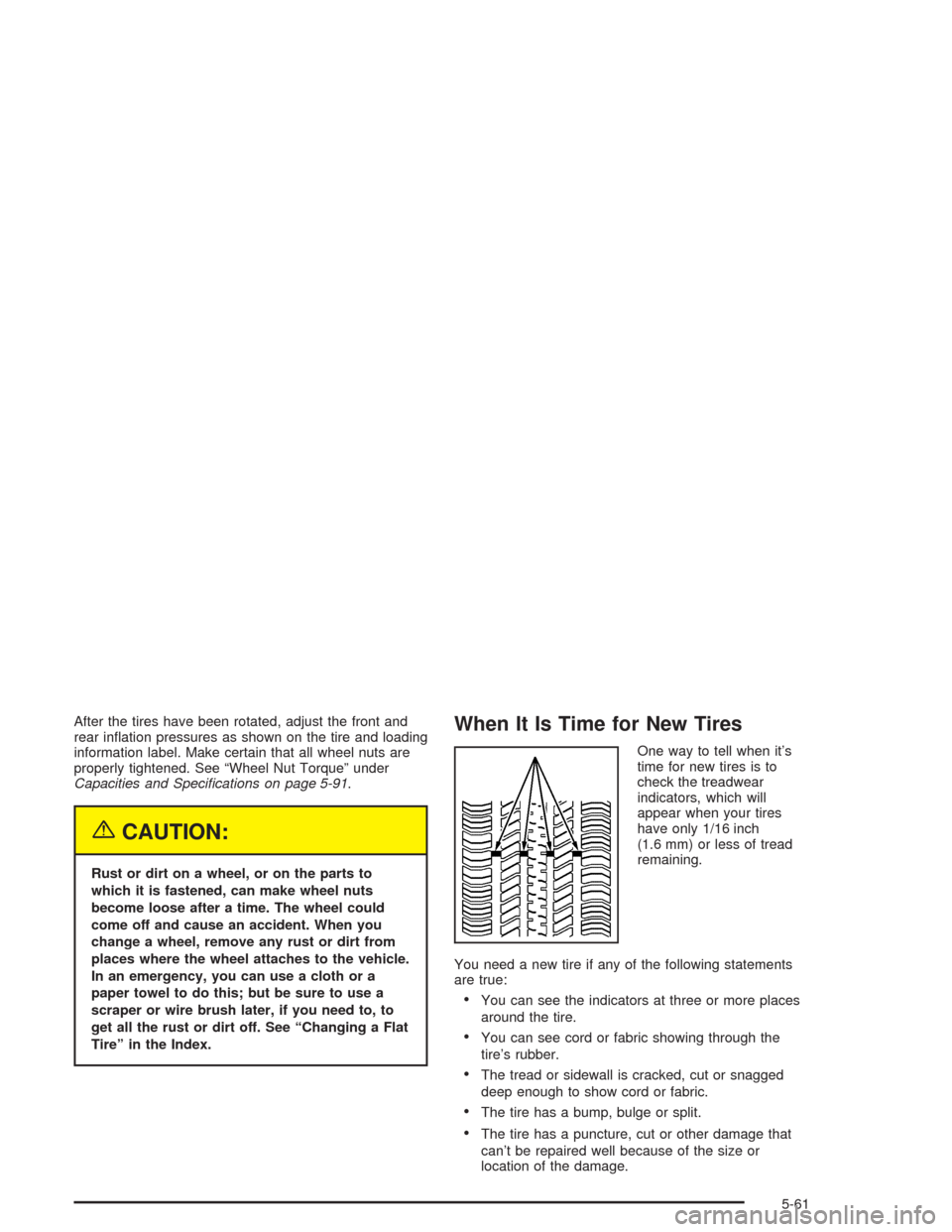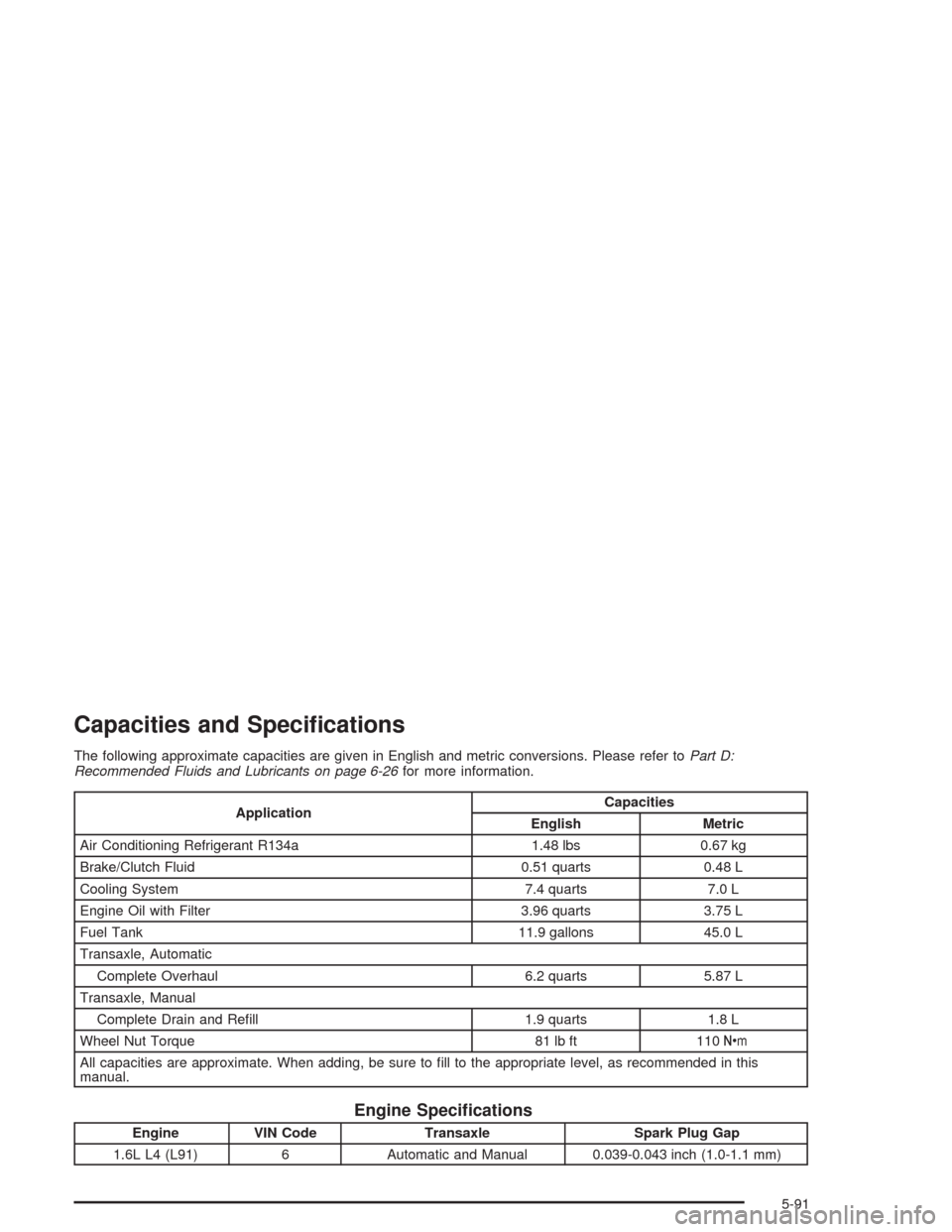2004 CHEVROLET AVEO torque
[x] Cancel search: torquePage 96 of 334

Torque Lock
If you are parking on a hill and you do not shift your
transaxle into PARK (P) properly, the weight of the
vehicle may put too much force on the parking pawl in
the transaxle. You may find it difficult to pull the shift
lever out of PARK (P). This is called “torque lock.”
To prevent torque lock, set the parking brake and then
shift into PARK (P) properly before you leave the
driver’s seat. To find out how, seeShifting Into Park (P)
(Automatic Transaxle) on page 2-29.
When you are ready to drive, move the shift lever out of
PARK (P)beforeyou release the parking brake.
If torque lock does occur, you may need to have another
vehicle push yours a little uphill to take some of the
pressure from the parking pawl in the transaxle, so you
can pull the shift lever out of PARK (P).
Shifting Out of Park (P)
(Automatic Transaxle)
Your automatic transaxle vehicle has an automatic
transaxle shift lock control system. You have to fully apply
your regular brakes before you can shift from PARK (P)
when the ignition is turned to ON. SeeAutomatic
Transaxle Operation on page 2-22.
If you cannot shift out of PARK (P) while holding the
brake pedal down, try this:
1. Set the parking brake.
2. Turn the ignition off and remove the key.
3. Remove the cover over the shift-lock release slot
by prying it off using a small, flat object, like a
screwdriver. The shift-lock release slot is located at
the top of the shift lever.
2-30
Page 224 of 334

Properly torqued wheel nuts are necessary to help
prevent brake pulsation. When tires are rotated, inspect
brake pads for wear and evenly tighten wheel nuts in
the proper sequence to GM torque specifications.
Your rear drum brakes do not have wear indicators, but
if you ever hear a rear brake rubbing noise, have the
rear brake linings inspected immediately. Also, the rear
brake drums should be removed and inspected each
time the tires are removed for rotation or changing.
When you have the front brake pads replaced, have the
rear brakes inspected, too.
Brake linings should always be replaced as complete
axle sets.
SeeBrake System Inspection on page 6-25.
Brake Pedal Travel
See your dealer if the brake pedal does not return to
normal height, or if there is a rapid increase in
pedal travel. This could be a sign of brake trouble.
Brake Adjustment
Every time you make a moderate brake stop, your disc
brakes adjust for wear. If you rarely make a moderate or
heavier stop, then your brakes might not adjust correctly.If you drive in that way, then – very carefully – make a
few moderate brake stops about every 1,000 miles
(1 600 km), so your brakes will adjust properly.
If your brake pedal goes down farther than normal, your
rear drum brakes may need adjustment. Adjust them by
backing up and firmly applying the brakes a few times.
Replacing Brake System Parts
The braking system on a vehicle is complex. Its many
parts have to be of top quality and work well together if
the vehicle is to have really good braking. Your vehicle
was designed and tested with top-quality GM brake parts.
When you replace parts of your braking system – for
example, when your brake linings wear down and you
need new ones put in – be sure you get new approved
GM replacement parts. If you do not, your brakes may no
longer work properly. For example, if someone puts in
brake linings that are wrong for your vehicle, the balance
between your front and rear brakes can change – for the
worse. The braking performance you have come to
expect can change in many other ways if someone puts
in the wrong replacement brake parts.
5-38
Page 247 of 334

After the tires have been rotated, adjust the front and
rear inflation pressures as shown on the tire and loading
information label. Make certain that all wheel nuts are
properly tightened. See “Wheel Nut Torque” under
Capacities and Specifications on page 5-91.
{CAUTION:
Rust or dirt on a wheel, or on the parts to
which it is fastened, can make wheel nuts
become loose after a time. The wheel could
come off and cause an accident. When you
change a wheel, remove any rust or dirt from
places where the wheel attaches to the vehicle.
In an emergency, you can use a cloth or a
paper towel to do this; but be sure to use a
scraper or wire brush later, if you need to, to
get all the rust or dirt off. See “Changing a Flat
Tire” in the Index.
When It Is Time for New Tires
One way to tell when it’s
time for new tires is to
check the treadwear
indicators, which will
appear when your tires
have only 1/16 inch
(1.6 mm) or less of tread
remaining.
You need a new tire if any of the following statements
are true:
•You can see the indicators at three or more places
around the tire.
•You can see cord or fabric showing through the
tire’s rubber.
•The tread or sidewall is cracked, cut or snagged
deep enough to show cord or fabric.
•The tire has a bump, bulge or split.
•The tire has a puncture, cut or other damage that
can’t be repaired well because of the size or
location of the damage.
5-61
Page 259 of 334

12. Tighten the wheel nuts
firmly in a crisscross
sequence, as shown.
{CAUTION:
Incorrect wheel nuts or improperly tightened
wheel nuts can cause the wheel to come loose
and even come off. This could lead to an
accident. Be sure to use the correct wheel
nuts. If you have to replace them, be sure to
get new GM original equipment wheel nuts.
Stop somewhere as soon as you can and have
the nuts tightened with a torque wrench to the
proper torque speci�cation. See “Capacities
and Speci�cations” in the Index for wheel nut
torque speci�cation.Notice:Improperly tightened wheel nuts can lead
to brake pulsation and rotor damage. To avoid
expensive brake repairs, evenly tighten the wheel
nuts in the proper sequence and to the proper
torque speci�cation. See “Capacities and
Speci�cations” in the Index for the wheel nut
torque speci�cation.
Do not try to put a wheel cover on your compact spare
tire. It will not fit. Store the wheel cover in the cargo
area until you have the flat tire repaired or replaced.
Notice:Wheel covers will not �t on your compact
spare. If you try to put a wheel cover on the
compact spare, you could damage the cover or
the spare.
5-73
Page 277 of 334

Capacities and Speci�cations
The following approximate capacities are given in English and metric conversions. Please refer toPart D:
Recommended Fluids and Lubricants on page 6-26for more information.
ApplicationCapacities
English Metric
Air Conditioning Refrigerant R134a 1.48 lbs 0.67 kg
Brake/Clutch Fluid 0.51 quarts 0.48 L
Cooling System 7.4 quarts 7.0 L
Engine Oil with Filter 3.96 quarts 3.75 L
Fuel Tank 11.9 gallons 45.0 L
Transaxle, Automatic
Complete Overhaul 6.2 quarts 5.87 L
Transaxle, Manual
Complete Drain and Refill 1.9 quarts 1.8 L
Wheel Nut Torque 81 lb ft 110Y
All capacities are approximate. When adding, be sure to fill to the appropriate level, as recommended in this
manual.
Engine Speci�cations
Engine VIN Code Transaxle Spark Plug Gap
1.6L L4 (L91) 6 Automatic and Manual 0.039-0.043 inch (1.0-1.1 mm)
5-91
Page 333 of 334

Tires (cont.)
If a Tire Goes Flat.......................................5-66
Inflation - Tire Pressure................................5-59
Inspection and Rotation................................5-60
Uniform Tire Quality Grading.........................5-63
Wheel Alignment and Tire Balance.................5-64
Wheel Replacement.....................................5-64
When It Is Time for New Tires......................5-61
Matching Transmitter(s) to Your Vehicle............... 2-5
To Use the Engine Coolant Heater....................2-21
Top Strap......................................................1-38
Top Strap Anchor Location...............................1-40
Torque Lock...................................................2-30
Towing
Recreational Vehicle.....................................4-29
Towing a Trailer..........................................4-37
Your Vehicle...............................................4-29
Transaxle
Fluid, Automatic...........................................5-21
Fluid, Manual..............................................5-21
Transaxle Operation, Automatic.........................2-22
Transaxle Operation, Manual............................2-26
Transmission, Transaxle, Transfer Case Unit
Repair Manual............................................7-11
Transportation Options...................................... 7-8
Trip Odometer................................................3-19
Trunk............................................................2-10
Turn and Lane-Change Signals.......................... 3-5
Turn Signal/Multifunction Lever........................... 3-5U
Underbody Flushing Service.............................6-23
Understanding Radio Reception........................3-43
Uniform Tire Quality Grading............................5-63
United States – Customer Assistance.................. 7-4
Used Replacement Wheels..............................5-65
Using an MP3 CD..........................................3-39
Using Cleaner on Fabric..................................5-77
Using the Rear Door Security Lock..................... 2-9
V
Vehicle
Control........................................................ 4-6
Damage Warnings........................................... iv
Loading......................................................4-32
Parking Your...............................................2-31
Symbols......................................................... iv
Vehicle Data Collection and Event Data
Recorders.................................................... 7-9
Vehicle Identification
Number (VIN).............................................5-83
Service Parts Identification Label...................5-84
Vehicle Storage..............................................5-39
Ventilation Adjustment......................................3-15
Visor Vanity Mirror..........................................2-14
Visors...........................................................2-14
13